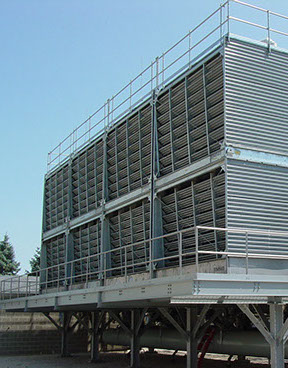

Lighting
NIU launched its first performance contract project in 2000, implementing lighting energy conservation measures (ECM’s) in eighteen buildings on campus. A second phase of lighting was implemented starting the following year in thirty-eight more buildings. Over the last ten years NIU replaced all inefficient T-12 lamps and magnetic ballasts, with T-8 lamps and electronic ballasts. NIU also installed LED exit signs, compact fluorescent lamps and occupancy sensors.
Heating
NIU upgraded boiler and boiler accessory controls to maximize boiler system efficiency, and installed stack economizers at heating plants to recapture waste heat from the boilers. Gas and steam meters have now been installed to track usage and efficiency of each boiler. Reverse osmosis systems have been installed to treat make-up water for the boilers more efficiently. Insulation jackets have been installed on steam valves a steam trap replacement program is currently being implemented.
Energy Conservation Measures
and Sustainability:
• Building Automation Control Systems
• Building Envelope Improvement


Cooling
NIU installed new energy efficient variable flow chillers, two way valves, variable speed drives on chilled water pump to maximize efficiency of chiller plants and chilled water distribution. Free cooling has been added to the Engineering Building chilled water system to allow winter chilled water to be produced without running chiller compressors.
HVAC
Each building distributes ventilation, heating and cooling through many types of air handling systems and unitary devices throughout the campus. This equipment often becomes damaged or worn out over time. NIU has implemented several projects that involve general fix-up and repair of existing equipment that allow the equipment to operate more efficiently and as originally intended. These measures include bur are not limited to sealing and patching leaky air handling unit casings, access doors, and ductwork, replacing insulation, repairing or replacing dampers that bring in outdoor air, replacing old motors with efficient motors with variable speed drives, replacing valves and heating and cooling coils, air and water balancing, and even cleaning ductwork. Each measure adds to the overall energy efficiency of the HVAC systems.
Building Automation Control Systems
A networked building automation system (BAS) is installed throughout the campus. Most of the building HVAC systems have been converted from stand-alone pneumatically controlled systems to DDC. The BAS connects all equipment to the facility network, and enables the facility management to more accurately and quickly control the building HVAC equipment operating schedules and space temperatures based on the actual events planned. In addition, it also helps facility management to quickly diagnose any problems that occur and plan scheduled maintenance. This saves labor costs for the University.
Building Envelope Improvement
Windows and doors are major sources of energy waste if they are not well insulated and properly sealed. Double pane windows have replaced old windows in Grant Tower C, Dorland Building, Anderson, Reavis, Watson, Zulauf, Cole and DuSable Halls, as well as other buildings. In addition, many old doors that were rusted, worn and in disrepair have been replaced with new well insulated and tighter new doors, and have been updated with ADA accessibility.
Renewable Energy – Solar Thermal for swimming pools
As a sustainable measure to save natural gas, NIU installed solar hot water heating systems for the indoor swimming pools at Gabel Hall and Anderson Hall. A solar hot water heating system, in conjunction with a pool cover eliminated the need for central plant steam for heating the pool water.
Water Conservation
Water conservation reduces costs of water and heating, and also helps make the campus more sustainable. NIU replaced plumbing fixtures (shower heads, faucets, toilets and flush valves and in dorms, and installed water saving foot operated valves in kitchens. In addition, many older water-cooled air conditioning equipment that used once-through tap water for cooling were replaced with energy efficient air cooled systems.